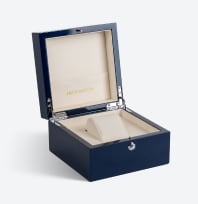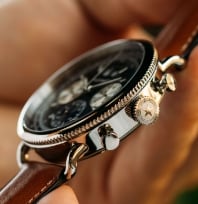For Hundreds Of Years, Watches Kept Time Without Battery Power.
For centuries, watches were made of entirely mechanical components. Long before the invention of electricity and battery power, watchmakers crafted watches that kept time with no batteries, microchips, or any other electronics. These watches were powered by mechanical movement, the oldest form of watch power ever invented.
Mechanical watches keep time through a staggeringly intricate combination of interconnected gears and other tiny components. These watches are composed of a set of sections known as bridges, which house a series of parts that regulate the release of energy from a coiled piece of metal called the mainspring. The mainspring in a mechanical watch stores energy when the watch’s wearer winds the watch by hand.
Winding a mechanical watch stores up kinetic energy in the mainspring. This energy is periodically released in carefully timed increments. A mechanism in a mechanical watch called the escapement regulates the release of energy from the mainspring. The escapement houses a fragile, oscillating component called the balance wheel, which triggers the timed release of a cog called the escape wheel. When the escape wheel is released, the mainspring releases energy, allowing the watch’s hands to turn.
Pre-battery watches are fascinating marvels of human ingenuity. Over the centuries, mechanical watch movement evolved, giving way to the rise of self-winding watches in the early 20th century. These automatic watches used the same type of mainspring-based winding system as traditional mechanical watches. However, an automatic watch uses a weighted rotor mechanism to harness the energy from the movements of the wearer’s wrist to wind the mainspring.
Mechanical and automatic watches both keep time to an impressive level of accuracy without the use of electronics or batteries. However, these watches are now rivaled by another form of watch movement that was introduced in the latter half of the 20th century.
The Rise Of The Quartz Watch
In the late 1960s, the legendary watchmakers Seiko introduced a new form of watch power that changed timekeeping forever. The battery-powered quartz mechanism first used by Seiko is now one of the dominant forms of watch movement on the modern market. Quartz watches are reliable, highly accurate, and easy to use with minimal maintenance and upkeep.
A quartz watch contains a small battery that generates an electrical current. This current vibrates a piece of quartz at a precise frequency, sending a signal to the watch that translates to a movement of the watch’s hands.
Quartz watches quickly became popular thanks to their accuracy, the elimination of the need for manual winding, and their reliability with minimal maintenance or upkeep. These watches have gone on to become the primary competitors of automatic watches, while mechanical watches have become largely obsolete.
Quartz Watches Vs. Automatic Watches
Automatic watches have been around longer than their quartz-powered counterparts and rely on a more traditional mechanism to keep time. Although they have found worthy competition in the form of quartz movement, automatic watches are still extremely popular today.
One of the major pros of choosing to wear an automatic instead of a quartz watch is the lack of a battery. Batteries need to be periodically replaced, whereas an automatic watch simply needs an occasional manual winding. The majority of the time, an automatic watch can rely solely on the energy harnessed from your wrist as you wear it.
Another perk of wearing an automatic watch is the weightiness of this type of timepiece. Automatics have a distinct heft to them thanks to the weight included in the rotor mechanism that allows the mainspring to wind itself. Automatic watches often feel inherently elegant thanks to this heaviness, which gives an automatic a unique feel when it is on your wrist. Quartz watches, on the other hand, are usually much lighter.
Quartz watches also have their own unique perks. Quartz movement never requires manual winding, making it especially convenient for anyone on a tight schedule. Quartz watches instead use battery power to keep time, with a much simpler and electronically integrated mechanism than traditional mechanical watches.
As for drawbacks, both of these types of watches have a few, but none too big to scare you away from either quartz or automatic movement. Automatic watches require a bit more attention than quartz watches in some cases, needing to be manually wound if they are left unworn for long enough. Because the primary source of energy for an automatic is the movements of the wearer’s wrist, it will eventually run out of stored energy in its mainspring if it is not worn frequently. This makes an automatic watch something of a commitment for the wearer.
On the other hand, quartz watches have one potential drawback to them – they are significantly less traditional in their inner workings. While quartz and automatic watches may look the same on the outside, the mechanisms that keep them ticking are entirely different.
The rich history of mechanical watches – and their direct descendants, automatics – often make them more attractive to purists and those who favor anything classic. Automatic movement dates further back than quartz movement, making it distinctly appealing to some in a way that quartz movement is not.
How Quartz Watch Movement Works, In Depth
Inside a quartz watch is a small battery, which provides an electrical current to a microchip. This microchip is programmed to produce a precise vibration, which it emits to a piece of quartz inside the watch. This quartz then vibrates at a specific amount of times per second.
The amount of vibrations per second in the piece of quartz inside a quartz watch is staggering – over 32,000. The quartz vibrates at this rate to keep the watch accurate, never deviating from their precise timing. The microchip inside the watch converts these vibrations into electricity, generated at a rate of one pulse of energy per second.
The pulses generated by the microchip inside a quartz watch are used to power a tiny motor. This motor turns a series of gears inside the watch, allowing the watch’s hands to turn in precise time with the signals emanated from the vibrating quartz. Now that the vibration has been translated into mechanical energy, it can be used to power a quartz watch for years at a time.
While the ticking of a quartz watch is permanently set by its inner mechanism to a fixed rate, the wearer sometimes still needs to make adjustments to the time displayed on his watch. These adjustments are made using a small knob on the watch called the crown. Automatic and mechanical watches also feature a crown, but the crowns included on these watches are used for both winding and setting time.
Quartz watch crowns do not provide energy to a mainspring, as a quartz watch does not rely on kinetic energy to tick. Instead, the crown on a quartz watch simply places the watch’s hands at a certain time. Then when the crown is pressed into its normal position, the watch resumes its normal rate of ticking.
Quartz Watch Batteries: How Long They Last, And How To Replace Them
The battery in a quartz watch is typically a 1.55V silver oxide battery. Some watches also use lithium batteries, silver peroxide, and even solar power for their batteries. Depending on the type of battery included in your watch, it may have a longer or shorter lifespan.
Quartz watch batteries are designed to last about two years but can sometimes keep your watch running for even longer. Determining what type of battery your quartz watch uses will help you get a sense of how long its battery’s life is and what type of battery you will need to purchase as a replacement.
Be prepared to replace your watch battery every couple of years. When it’s time to replace your watch battery, it’s best to do so with a pair of tweezers instead of trying to use your hands. The oil on your fingers can potentially harm the inner workings of your quartz watch, so using tweezers instead is the best way to avoid damage.
The backplate of your quartz watch should be removable with a small screwdriver. Some quartz watch batteries are also held in place by a tiny screw. Others are simply resting in place, in which case a pair of tweezers is all you need to remove the battery.
Once you have the backplate of your watch open, gently remove your watch’s spent battery and use your tweezers to put a new one in place. Double-check that your new battery is the same type as your old one – the wrong battery will leave your watch non-functioning at best and can cause permanent damage at worst.
Once you have placed the new battery in its slot using tweezers, replace the screw holding it in place if one is present. Then, screw the backplate of your watch back into place, and your watch should be up and running again for another several years.
Sources:
https://www.explainthatstuff.com/quartzclockwatch.html
https://www.watchstyle.com/assembly-and-repair/replacing-the-battery.html











